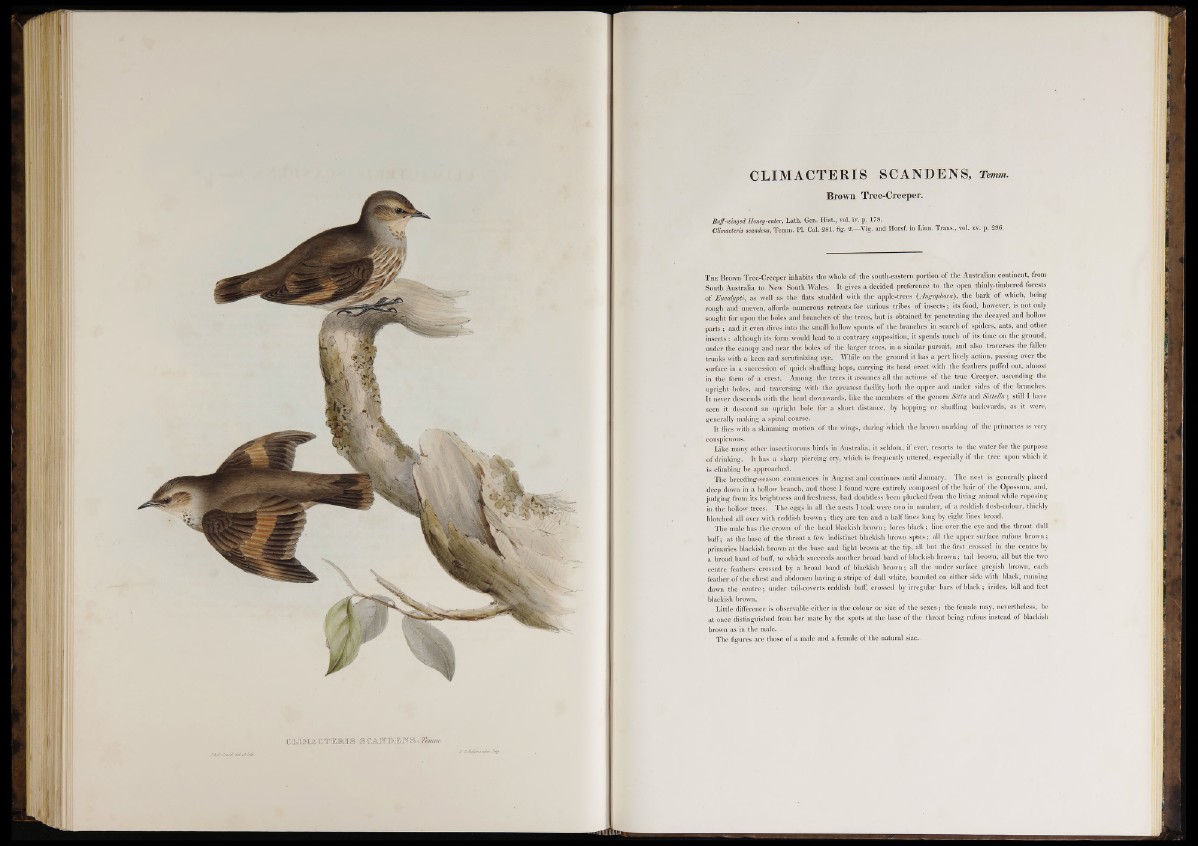
C UM A C T E JM S SC A K B K K S ¡Term .
CLIMACTERIS SCANDENS, Temm.
Brown Tree-Creeper.
Buff-winged Honey-eater, Lath. Gen. Hist., vol. iv. p. 178.
Clvmacteris scandens, Temm. PI. Col. 281. fig. 2 —Vig. and Horsf. in Linn. Trans., vol. xy. p. 296.
T h e Brown Tree-Creeper inhabits the whole o f the south-eastern portion of the Australian continent, from
South Australia to New South Wales. It gives a decided preference to the open thinly-timbered forests
o f Eucalypti, as well as the flats studded with the apple-trees (Angophora) , the bark o f which, being
rough and uneven, affords numerous retreats for various tribes of insects; its food, however, is not only
sought for upon the boles and branches of the trees, but is obtained by penetrating the decayed and hollow
parts ; and it even dives into the small hollow spouts o f the branches in search of spiders, ants, and other
insects : although its form would lead to a contrary supposition, it spends much of its time on the ground,
under the canopy and near the boles o f the larger trees, in a similar pursuit, and also traverses the fallen
trunks with a keen and scrutinizing eye. While on the ground it has a pert lively action, passing over the
surface in a succession of quick shuffling hops, carrying its head erect with the feathers puffed out, almost
in the form of a crest. Among the trees it assumes all the actions of the true Creeper, ascending the
upright boles, and traversing with the greatest facility both the upper and under sides of the branches.
It never descends with the head downwards, like the members of the genera Sitta and Sittella; still I have
seen it descend an upright bole for a short distance, by hopping or shuffling backwards, as it were,
generally making a spiral course.
It flies with a skimming motion of the wings, during which the brown marking of the primaries is very
conspicuous.
Like many other insectivorous birds in Australia, it seldom,' if ever, resorts to the water for the purpose
of drinking. It has a sharp piercing cry, which is frequently uttered, especially if the tree upon which it
is climbing be approached.
The breeding-season commences in August and continues until January. The nest is generally placed
deep down in a hollow branch, and those I found were entirely composed of the hair of the Opossum, and,
judging from its brightness and freshness, had doubtless been plucked from the living animal while reposing
in the hollow trees. The eggs in all the nests I took were two in number, of a reddish flesh-colour, thickly
blotched all over with reddish brown; tbey are ten and a half lines long by eight lines broad.
The male has the crown of the head blackish brown; lores black; line over .the eye and the throat dull
buff; at the base of the throat a few indistinct blackish brown spots; all the upper surface rufous brown;
primaries blackish brown at the base and light brown at the tip, all but the first crossed in the centre by
a broad band of buff, to which succeeds another broad band of blackish brown; tail brown, all but the two
centre feathers crossed by a broad band of blackish brown; all the under surface greyish brown, each
feather of the chest and abdomen having a stripe of dull white, bounded on either side with black, running
down the centre; under tail-coverts reddish buff, crossed by irregular bars o f black ; irides, bill and feet
blackish brown.
Little difference is observable either in the colour or size of the sexes; the female may, nevertheless, be
at once distinguished from her mate by the spots at the base of the throat being rufous instead o f blackish
brown as in the male. >
The figures are those of a male and a female of the natural size.-.